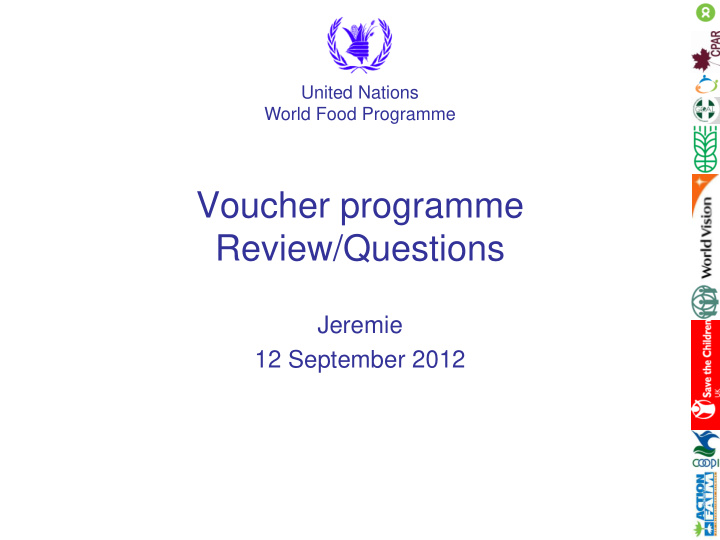



United Nations World Food Programme Voucher programme Review/Questions Jeremie 12 September 2012
Modality of transfer Rather than asking about preferences, it asks about the situations in which each modality would be appropriate Context (Large scale emergency / Safety Net) Beneficiary preference / type Combined approach? 2 2
Objective of the assistance? Entry Point Is it an emergency response ? Look at cost effectiveness/efficiency Is it a nutritional support ? Improve the quality of beneficiary’s diet, especially its diversity? What nutrional gap to be covered and which population to target? Is it to increase choices and dignity? Is it to support the local economy ? To strengthen and support stronger development of local food production/food processing? Is it a safety net support ? Income support to poorest population? Which gap need to be covered? Criteria of poverty? Is the voucher objective limited to fill the poverty gap for the poorest households only? How long should be the assistance provided? At stake : - Cost effectivness/efficiency and quality programme (issue of comparison while ojbectives of programmes are different) - Exit strategy 3 3
Targeting • Profiling of target groups for various type of assistance package, based on existing/collected data (baseline allowing further targeted field research). • Better understanding of poverty, sharing and support system within communities, type of coping mechanisms used. • Better mapping of support/assistance provided at household level – Strengthened coordination among FS stakeholders • Issue of inclusion/exclusion errors – Communtiy based approach while having a clear set of targeting criteria (mix of Cty / Socio- Economic Indicators – Income and assets related / Vulnerability criteria At stake : - Common understanding of poverty - Potential development of a shared household profiling/database (who is the custodian – Authorities?). - Potential for re-targeting (mid term review) 4
Family size • Issue with in-kind / family categorization. • Voucher allows move away from standard package. It allows to apply the assistance to the actual household size rather than by category size (using the database in place) or clustered into groups. • Current system in place with 2,000 HTG provided to the overall family raises raises issue of faireness and equity. • Ensure the definition of the household/family size (those eating from the same plate). Issue with extended families. It will impact the value transfer and help better understaning of the sharing among familly members/relatives. At stake : - Voucher Value transfer - Fairness of the project - Dynamic of households composition 5 5
Value of transfer • Looking at your objective, is it based on a food basket (staple food?) or based on nutritional food (look at nutritional gap of poorest families – address issue of protein/micronutrients). • What is the consumption gap to be covered, up to which level? Objective of uplifting housholds from their current poverty status? • What about inflation? Ceiling of transfer to adapt to the market cost? Contingency in place up to which level of price increase (10%?). At stake : - Too often the value of the voucher or the cash is applying the same transfer value of any in-kind general food distribution while it should relate to the objectives of the project. 6
Indicators • Looking at your objective, is it just a support package (emergency ad-hoc support / safety net) or it aims to provide support for tansitioning or graduating out of the programme in place. • If you intervention aims at improving dietary diversty or food security without uplifting households conditions (targeting poorest families), then removing the intervention will only bring the beneficiaries back to their initial state. • Which baseline with key food security indicators inserted to measure the short/medium term impact of the project. • If local food production is among the primary objective of the project, what indicators are in place to capture the impact of the project? At stake : - For the development of a safety net, poverty levels endorsed at national level would help determining consumption gap (up to a defined poverty lines – food only or essential needs?) - Poverty definition allowing FS stakeholders to refine the type of assistance package to be provided based on their objectives. 7
Monitoring • Cash and vouchers tend to attract heavier monitoring (normal as pilot), yet it is also influenced by the nature of the transfer. • Monitoring tends to extend further beyond the point of transfer to beneficiaries and probe more into the use of the resources. • Monitoring is focusing more on the implementation side than on the actual objective of the intervention. • After pilot phase, shop monitoring should not remain at 100%. • If commodities redeemed could be inserted in the e-voucher system, then after pilot phase is finalized, paper monitoring at shop level could be reduced only for a validation system (spot check) and payments at shops purely based on the electronic system. At stake : - Monitoring load should reflect the purpose of the monitoring, rather than being influenced by the modality. 8 8
Side effects / 2ndary economic impact • Social dimension – reliable and sufficient source of food/income reducing stress at household level having direct impact on domestic/gender based violence. Looking at your objective, is it based on a food basket (staple food?) or based on nutritional food (look at nutritional gap of poorest families – address issue of protein/micronutrients). • Dignity / Enpowerment – increased dignity associated with shopping as opposed to collecting rations (choice of products, resilience strategy). • Local production – Haiti dominated by imports. Local products have to overcome perceptions of being of lower quality. If local processed/produce food as an objective, it can impact on beneficiarie’s food quality perception. At stake: -The impact of these aspects cannot be calculated but should not be under ‐ estimated (could be developed in FG discussions – qualitative information or via 2ndary impact monitoring for local production). 9
Recommend
More recommend